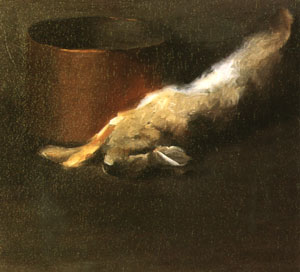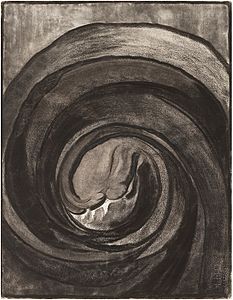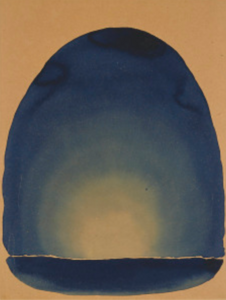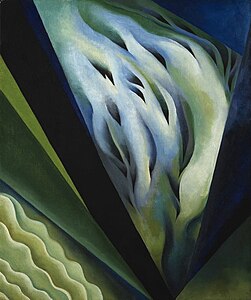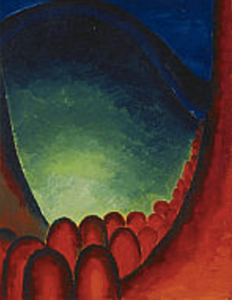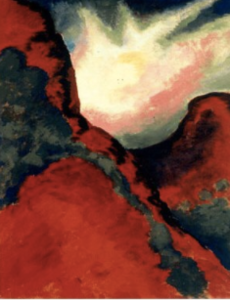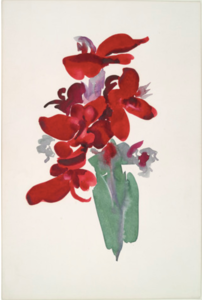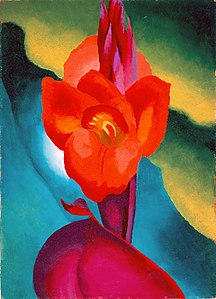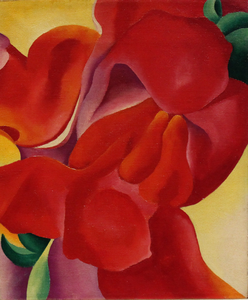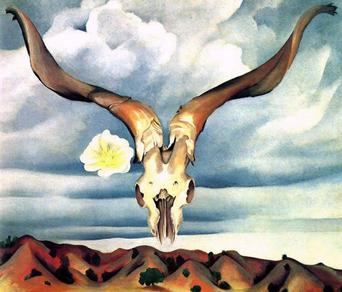Georgia O'Keeffe
Georgia O'Keeffe | |
|---|---|
 O'Keeffe in 1932, photograph byAlfred Stieglitz | |
| Born | Georgia Totto O'Keeffe November 15, 1887 |
| Died | March 6, 1986(aged 98) Santa Fe, New Mexico,U.S. |
| Known for | Visual arts: painting, sculpture, photography |
| Movement | American modernism,Precisionism |
| Spouse | |
| Family | Ida O'Keeffe(younger sister) |
| Awards | National Medal of Arts(1985) Presidential Medal of Freedom(1977) Edward MacDowell Medal(1972) |
Georgia Totto O'Keeffe(November 15, 1887 – March 6, 1986) was an Americanmodernistpainter anddraftswomanwhose career spanned seven decades and whose work remained largely independent of majorart movements.Called the "Mother of American modernism", O'Keeffe gained international recognition for her meticulous paintings of natural forms, particularly flowers and desert-inspired landscapes, which were often drawn from and related to places and environments in which she lived.[1][2]
From 1905, when O'Keeffe began her studies at theSchool of the Art Institute of Chicago,until about 1920, she studied art or earned money as a commercial illustrator or a teacher to pay for further education.[3][4]Influenced byArthur Wesley Dow,O'Keeffe began to develop her unique style beginning with her watercolors from her studies at theUniversity of Virginiaand more dramatically in the charcoal drawings that she produced in 1915 that led to total abstraction.Alfred Stieglitz,an art dealer and photographer, held an exhibit of her works in 1917.[5]Over the next couple of years, she taught and continued her studies at theTeachers College, Columbia University.
She moved toNew Yorkin 1918 at Stieglitz's request and began working seriously as an artist.[6]They developed a professional and personal relationship that led to their marriage on December 11, 1924.[7]O'Keeffe created many forms of abstract art, including close-ups of flowers, such as theRed Cannapaintings, that many found to represent vulvas,[8]though O'Keeffe consistently denied that intention.[9]The imputation of the depiction of women's sexuality was also fueled by explicit and sensuous photographs of O'Keeffe that Stieglitz had taken and exhibited.
O'Keeffe and Stieglitz lived together in New York until 1929, when O'Keeffe began spending part of the year in the Southwest, which served as inspiration for her paintings of New Mexico landscapes and images of animal skulls, such asCow's Skull: Red, White, and Blue(1931) andSummer Days(1936).After Stieglitz's death in 1946, she lived in New Mexico for the next 40 years ather home and studioorGhost Ranchsummer home inAbiquiú,and in the last years of her life, inSanta Fe.In 2014, O'Keeffe's 1932 paintingJimson Weed/White Flower No. 1sold for $44,405,000—at the time, by far the largest price paid for any painting by a female artist.[10]Her works are in the collections of several museums, and following her death, theGeorgia O'Keeffe Museumwas established in Santa Fe.
Early life and education (1887–1916)[edit]

Georgia O'Keeffe was born on November 15, 1887,[15][16]in a farmhouse in the town ofSun Prairie, Wisconsin.[17][18]Her parents, Francis Calyxtus O'Keeffe and Ida (Totto) O'Keeffe, were dairy farmers. Her father was of Irish descent. Her mother's father, George Victor Totto, for whom O'Keeffe was named, was a Hungariancountwho came to the United States in 1848.[15][19]
O'Keeffe was the second of seven children.[15]She attended Town Hall School in Sun Prairie.[20]By age 10, she had decided to become an artist.[21]With her sisters,Idaand Anita,[22]she received art instruction from local watercolorist Sara Mann. O'Keeffe attended high school atSacred Heart Academyin Madison, Wisconsin, as a boarder between 1901 and 1902. In late 1902, the O'Keeffes moved from Wisconsin to the close-knit neighborhood ofPeacock HillinWilliamsburg, Virginia,where O'Keeffe's father started a business makingrusticated cast concrete blockin anticipation of a demand for the block in theVirginia Peninsulabuilding trade, but the demand never materialized.[23]O'Keeffe stayed in Wisconsin attendingMadison Central High School[24]until joining her family in Virginia in 1903. She completed high school as a boarder at Chatham Episcopal Institute in Virginia (nowChatham Hall), graduating in 1905. At Chatham, she was a member ofKappa Deltasorority.[15][20]
O'Keeffe taught and headed the art department atWest Texas State Normal College,watching over her youngest sibling, Claudia, at her mother's request.[25]In 1917, she visited her brother, Alexis, at a military camp in Texas before he shipped out for Europe duringWorld War I.While there, she created the paintingThe Flag,[26]which expressed her anxiety and depression about the war.[19]
- Early works
-
Untitled (Vase of Flowers),1903–1905, watercolor on paper,Georgia O'Keeffe Museum
-
Untitled (Dead Rabbit with the Copper Pot),1908,Art Students League of New York
-
Scrapbook (The Rotunda at University of Virginia),1912–1914, watercolor on paper,University of Virginia
Academic training[edit]

From 1905 to 1906, O'Keeffe was enrolled at theSchool of the Art Institute of Chicago,where she studied withJohn Vanderpoeland ranked at the top of her class.[15][21]As a result of contractingtyphoid fever,she had to take a year off from her education.[15]In 1907, she attended theArt Students Leaguein New York City, where she studied underWilliam Merritt Chase,Kenyon Cox,andF. Luis Mora.[15]In 1908, she won the League's William Merritt Chase still-life prize for her oil paintingDead Rabbit with Copper Pot.Her prize was a scholarship to attend the League's outdoor summer school inLake George,New York.[15]While in the New York City, O'Keeffe visited galleries, such as291,co-owned by her future husband, photographer Alfred Stieglitz. The gallery promoted the work of avant-garde artists and photographers from the United States and Europe.[15]
In 1908, O'Keeffe discovered that she would not be able to finance her studies. Her father had gone bankrupt and her mother was seriously ill withtuberculosis.[15]She was not interested in a career as a painter based on the mimetic tradition that had formed the basis of her art training.[21]She took a job inChicagoas a commercial artist and worked there until 1910, when she returned to Virginia to recuperate from themeasles[27]and later moved with her family toCharlottesville, Virginia.[15]She did not paint for four years and said that the smell ofturpentinemade her ill.[21]She began teaching art in 1911. One of her positions was at her former school, Chatham Episcopal Institute, in Virginia.[15][28]
First abstractions[edit]
She took a summer art class in 1912 at theUniversity of VirginiafromAlon Bement,who was aColumbia University Teachers Collegefaculty member. Under Bement, she learned of the innovative ideas ofArthur Wesley Dow,Bement's colleague. Dow's approach was influenced by principles of design and composition in Japanese art. She began to experiment with abstract compositions and develop a personal style that veered away from realism.[15][21]From 1912 to 1914, she taught art in the public schools inAmarilloin theTexas Panhandle,and was a teaching assistant to Bement during the summers.[15]She took classes at the University of Virginia for two more summers.[29]She also took a class in the spring of 1914 at Teachers College of Columbia University with Dow, who further influenced her thinking about the process of making art.[30]Her studies at the University of Virginia, based upon Dow's principles, were pivotal in O'Keeffe's development as an artist. Through her exploration and growth as an artist, she helped to establish theAmerican modernismmovement.
- First abstractions
-
Special Drawing No. 2,1915, charcoal on laid paper,National Gallery of Art
-
Special No. 8,1916, charcoal on paper,Whitney Museum
-
Sunrise,1916, watercolor on paper
She taught atColumbia CollegeinColumbia, South Carolinain late 1915, where she completed a series of highly innovativecharcoal abstractions[21]based on her personal sensations.[28]In early 1916, O'Keeffe was in New York at Teachers College, Columbia University. She mailed the charcoal drawings to a friend and former classmate at Teachers College, Anita Pollitzer, who took them to Alfred Stieglitz at his 291 gallery early in 1916.[31]Stieglitz found them to be the "purest, finest, sincerest things that had entered 291 in a long while" and said that he would like to show them. In April that year, Stieglitz exhibited ten of her drawings at 291.[15][21]
After further course work at Columbia in early 1916 and summer teaching for Bement,[15]she became the chair of the art department atWest Texas State Normal College,inCanyon, Texas,beginning in the fall of 1916.[32]O'Keeffe, who enjoyed sunrises and sunsets, developed a fondness for intense and nocturnal colors. Building upon a practice she began in South Carolina, O'Keeffe painted to express her most private sensations and feelings. Rather than sketching out a design before painting, she freely created designs. O'Keeffe continued to experiment until she believed she truly captured her feelings in the watercolor,Light Coming on the PlainsNo. I(1917).[28]
- Abstractions
-
Light Coming on the Plains No. II,1917, watercolor on newsprint paper,Amon Carter Museum of American Art
-
Series 1, No. 8,1918, oil painting on canvas,Lenbachhaus,Munich
-
Blue and Green Music,1921, oil on canvas,Art Institute of Chicago
She began a series of watercolor paintings based upon the scenery and expansive views during her walks,[28][33]includingvibrant paintingsofPalo Duro Canyon.[34]She "captured a monumental landscape in this simple configuration, fusing blue and green pigments in almost indistinct tonal graduations that simulate the pulsating effect of light on the horizon of the Texas Panhandle," according to author Sharyn Rohlfsen Udall.[28][33]
- Palo Duro Canyon
-
Canyon with Crows,1917, watercolor and graphite on paper, Georgia O'Keeffe Museum
-
No. 20 Special,oil on board, 1916–1917, Milwaukee Art Museum
-
Palo Duro Canyon,1916–1917, watercolor, West Texas A&M University
New York (1918–1930s)[edit]

Stieglitz circle[edit]
In 1918, O'Keeffe moved to New York as Stieglitz offered to provide financial support,[35]a residence, and place for her to paint. They developed a close personal relationship, and later married, while he promoted her work.[15]Stieglitz also discouraged her use of watercolor, which was associated with amateur women artists.[35]According to art historian Charles Eldredge, "the couple enjoyed a prominent position in the ebullient art of New York throughout the 1920s".[36]
O'Keeffe came to know the many early American modernists who were part of Stieglitz's circle of artists, including paintersCharles Demuth,Arthur Dove,Marsden Hartley,John Marin,and photographersPaul StrandandEdward Steichen.Strand's photography, as well as that of Stieglitz, inspired O'Keeffe's work. Stieglitz, whose 291 Gallery closed down in 1917, was now able to spend more time on his own photographic practice, producing a series of photographs of natural forms, cloud studies (a series known asEquivalents), and portraits of O'Keeffe.[36]Prior to her marriage to Stieglitz, O'Keeffe's drawings and paintings were frequently abstract, although she began to expand her visual vocabulary from 1924 onward to include more representational imagery "usually taken from nature and often painted in series".[37]
Flower paintings[edit]
O'Keeffe began creating simplified images of natural things, such as leaves, flowers, and rocks.[38]Inspired byPrecisionism,The Green Apple,completed in 1922, depicts her notion of simple, meaningful life.[39]O'Keeffe said that year, "it is only by selection, by elimination, and by emphasis that we get at the real meaning of things."[39]Blue and Green Musicexpresses O'Keeffe's feelings about music through visual art, using bold and subtle colors.[40]
Also in 1922, journalistPaul Rosenfeldcommented "[the] Essence of very womanhood permeates her pictures", citing her use of color and shapes as metaphors for the female body.[41]This same article also describes her paintings in a sexual manner.[41]O'Keeffe, most famous for her depiction of flowers, made about 200flower paintings,[42]which by the mid-1920s were large-scale depictions of flowers, as if seen through a magnifying lens, such asOriental Poppies[43][44]and severalRed Cannapaintings.[45]She painted her first large-scale flower painting,Petunia, No. 2,in 1924 and it was first exhibited in 1925.[15]Making magnified depictions of objects created a sense of awe and emotional intensity.[38]In 1924, Stieglitz arranged a show displaying O'Keeffe's works of art alongside his photographs atAnderson Galleriesand helped organized other exhibitions over the next several years.[46]
- Red Canna (1915–1923)
-
Red Canna,1915,Yale University Art Gallery
-
Red Canna,1919, oil on board,High Museum of Art,Atlanta
-
Red Canna,1923, oil-painting on canvas,Pennsylvania Academy of the Fine Arts
New York Skyscraper paintings[edit]

After having moved into a 30th floor apartment in theShelton Hotelin 1925,[47]O'Keeffe began a series of paintings of theNew York skyscrapersand skyline.[48]One of her most notable works, which demonstrates her skill at depicting the buildings in the Precisionist style, is theRadiator Building–Night, New York.[49][50]Other examples areNew York Street with Moon(1925),[51]The Shelton with Sunspots, N.Y.(1926),[52]andCity Night(1926).[15]She made a cityscape,East River from the Thirtieth Story of the Shelton Hotelin 1928, a painting of her view of theEast Riverand smoke-emitting factories in Queens.[48]The next year she made her final New York City skyline and skyscraper paintings and traveled to New Mexico, which became a source of inspiration for her work.[49]
TheBrooklyn Museumheld a retrospective of her work in 1927.[31]In 1928, Stieglitz announced that six of hercalla lilypaintings sold to an anonymous buyer in France for US$25,000, but there is no evidence that this transaction occurred the way Stieglitz reported.[53][54]As a result of the press attention, O'Keeffe's paintings sold at a higher price from that point onward.[55][54]
New Mexico (1930s–1986)[edit]
By 1929, she traveled toSanta Fefor the first time,[56]accompanied by her friendRebecca (Beck) Strandand stayed inTaoswithMabel Dodge Luhan,who provided the women with studios.[57]From her room she had a clear view of theTaos Mountainsas well as themorada(meetinghouse) of theHermanos de la Fraternidad Piadosa de Nuestro Padre Jesús Nazareno,also known as thePenitentes.[58]She subsequently visited New Mexico on near annual basis from 1929 onward, often staying there several months at a time, returning to New York each winter to exhibit her work atStieglitz's gallery.[59]O'Keeffe went on manypack trips,exploring the rugged mountains and deserts of the region that summer and later visited the nearbyD. H. Lawrence Ranch,[57]where she completed her now famous oil painting,The Lawrence Tree,currently owned by theWadsworth AthenaeuminHartford,Connecticut.[60]O'Keeffe visited and painted the nearby historicalSan Francisco de Asís Mission ChurchatRanchos de Taos.She made several paintings of the church, as had many artists, and her painting of a fragment of it silhouetted against the sky captured it from a unique perspective.[61][62]
In New Mexico, she collected rocks and bones from the desert floor and made them and the distinctive architectural and landscape forms of the area subjects in her work.[38]Known as a loner, O'Keeffe often explored the land she loved in herFord Model A,which she purchased and learned to drive in 1929. She often talked about her fondness for Ghost Ranch and Northern New Mexico, as in 1943, when she explained, "Such a beautiful, untouched lonely feeling place, such a fine part of what I call the 'Faraway'. It is a place I have painted before... even now I must do it again."[62]O'Keeffe did not work from late 1932 until about the mid-1930s[62]due to nervous breakdowns.[35]She was a popular artist, receiving commissions while her works were being exhibited in New York and other places.[63]
Skull and desert motifs[edit]
In 1933 and 1934, O'Keeffe recuperated inBermudaand returned to New Mexico in 1934.[62]In August 1934, she moved to Ghost Ranch, north of Abiquiú. In 1940, she moved into a house on the ranch property. The varicolored cliffs surrounding the ranch inspired some of her most famous landscapes.[62]Between 1934 and 1936, she completed a series of landscape paintings inspired by the New Mexico desert, often with prominent depictions of animal skulls, includingRams Head with Hollyhock(1935) andDeer's Head with Pedernal(1936) as well asSummer Days(1936).[64]In 1936, she completed what would become one of her best-known paintings,Summer Days.It depicts a desert scene with a deer skull with vibrant wildflowers. ResemblingRam's Head with Hollyhock,it depicted the skull floating above the horizon.[63][65]
- Skulls and desert motif
-
Summer Days,1936, oil on canvas,Whitney Museum of American Art
-
Ram's Head White Hollyhock and Little Hills,1935, oil on canvas,Brooklyn Museum
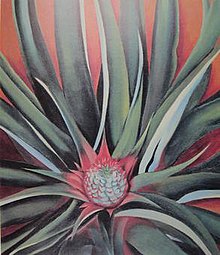
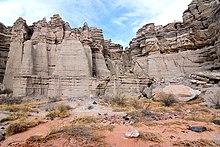
In 1938, the advertising agencyN. W. Ayer & Sonapproached O'Keeffe about creating two paintings for the Hawaiian Pineapple Company (nowDole Food Company) to use in advertising.[66][67][68]Other artists who produced paintings of Hawaii for the Hawaiian Pineapple Company's advertising includeLloyd Sexton, Jr.,Millard Sheets,Yasuo Kuniyoshi,Isamu Noguchi,andMiguel Covarrubias.[69]The offer came at a critical time in O'Keeffe's life: she was 51, and her career seemed to be stalling (critics were calling her focus on New Mexico limited, and branding her desert images "a kind of mass production" ).[70]
She arrived in Honolulu February 8, 1939, aboard theSSLurlineand spent nine weeks inOahu,Maui,Kauai,and theisland of Hawaii.By far the most productive and vivid period was on Maui, where she was given complete freedom to explore and paint.[70][71]She painted flowers, landscapes, and traditional Hawaiian fishhooks. Back in New York, O'Keeffe completed a series of 20 sensual, verdant paintings. However, she did not paint the requested pineapple until the Hawaiian Pineapple Company sent a plant to her New York studio.[72]
During the 1940s, O'Keeffe had two one-woman retrospectives, the first at theArt Institute of Chicago(1943).[38]Her second was in 1946, when she was the firstwoman artistto have a retrospective at theMuseum of Modern Art(MoMA) in Manhattan.[42]Whitney Museumbegan an effort to create the first catalogue of her work in the mid-1940s.[63]
Abiquiú and landscapes[edit]
In 1945, O'Keeffe bought a second house, an abandonedhaciendain Abiquiú, which she renovated into a home and studio.[73]She moved permanently to New Mexico in 1949, spending time at both Ghost Ranch and the Abiquiú house that she made into her studio.[38][46]
Todd Webb,a photographer she met in the 1940s, moved to New Mexico in 1961. He often made photographs of her, as did numerous other important American photographers, who consistently presented O'Keeffe as a "loner, a severe figure and self-made person."[74]While O'Keeffe was known to have a "prickly personality," Webb's photographs portray her with a kind of "quietness and calm" suggesting a relaxed friendship, and revealing new contours of O'Keeffe's character.[75]
In the 1940s, O'Keeffe made an extensive series of paintings of what is called the "Black Place", about 150 miles (240 km) west of her Ghost Ranch house.[76]O'Keeffe said that the Black Place resembled "a mile of elephants with gray hills and white sand at their feet."[62]She made paintings of the "White Place", a white rock formation located near her Abiquiú house.[77]In 1946, she began making the architectural forms of her Abiquiú house—the patio wall and door—subjects in her work.[78]It was in this period that O'Keefe also worked seriously with photography, providing striking counterparts to her patio / door painting.[79]Another distinctive painting wasLadder to the Moon,1958.[80]In the mid-1960s, O'Keeffe producedSky Above Clouds,a series ofcloudscapesinspired by her views from airplane windows.[38][b]Worcester Art Museumheld a retrospective of her work in 1960[31]and ten years later, the Whitney Museum of American Art mounted theGeorgia O'Keeffe Retrospective Exhibition.[46]
Late career and death[edit]
| External images | |
|---|---|
By 1972, O'Keeffe had lost much of her eyesight due tomacular degeneration,[84]leaving her with onlyperipheral vision.She stopped oil painting without assistance in 1972.[85]In 1973, O'Keeffe hired John Bruce "Juan" Hamilton as a live-in assistant and then a caretaker. Hamilton was a potter.[86]Hamilton taught O'Keeffe to work with clay, encouraged her to resume painting despite her deteriorating eyesight, and helped her write her autobiography. He worked for her for 13 years.[38]The artist's autobiography,Georgia O'Keeffe,published in 1976 byViking Press,featuredSummer Days(1936) on the cover. It became a bestseller.[46]During the 1970s, she made a series of works in watercolor.[87]She continued working in pencil and charcoal until 1984.[84]
O'Keeffe became increasingly frail in her late nineties. She moved to Santa Fe in 1984, where she died on March 6, 1986, at the age of 98.[88]Her body was cremated and her ashes were scattered, as she wished, on the land around Ghost Ranch.[89]Following O'Keeffe's death, her family contested her will becausecodicilsadded to it in the 1980s had left most of her $65 million estate to Hamilton. The case was ultimately settled out of court in July 1987.[89][90]The case became a famous precedent inestate planning.[91][92]
Reception[edit]
Awards and honors[edit]
| External videos | |
|---|---|
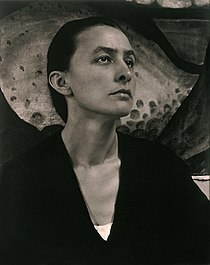 | |
In 1938, O'Keeffe received an honorary degree of "Doctor of Fine Arts" from theCollege of William & Mary.[93]Later, O'Keeffe was elected to theAmerican Academy of Arts and Letters[31]and in 1966 was elected a Fellow of theAmerican Academy of Arts and Sciences.[94]Among her awards and honors, O'Keeffe received the M. Carey Thomas Award atBryn Mawr Collegein 1971 and two years later received an honorary degree fromHarvard University.[31]
In 1977,PresidentGerald Fordpresented O'Keeffe with thePresidential Medal of Freedom,the highest honor awarded to American civilians.[95]In 1985, she was awarded theNational Medal of Artsby PresidentRonald Reagan.[46]In 1993, she was inducted into theNational Women's Hall of Fame.[96]
Art criticism and scholarship[edit]
O'Keeffe's lotus paintings may have deeper ties to vulvar imagery and symbolism. In Egyptian mythology, lotus flowers are a symbol of the womb, and in Indian mythology, they are direct symbols for vulvas.[97]Feminist art historianLinda Nochlinand the author of the influential 1971 essay titled "Why Have There Been No Great Women Artists?",also interpretedBlack Iris III(1926) as a morphological metaphor for a vulva.[98][99]
Art dealerSamuel Kootzwas one of O'Keeffe's critics who, although considering her to be "the only prominent woman artist" (in the words of Marilyn Hall Mitchell), considered sexual expression in her work (and other artists' work) artistically problematic.[100]Kootz stated that "assertion of sex can only impede the talents of an artist, for it is an act of defiance, of grievance, in which the consciousness of these qualities retards the natural assertions of the painter".[100]
O'Keeffe stood her ground against sexual interpretations of her work, and for fifty years maintained that there was no connection between vulvas and her artwork.[100]Firing back against some of the criticism, O'Keeffe stated, "When people read erotic symbols into my paintings, they're really talking about their own affairs."[101]She attributed other artists' attacks on her work topsychological projection.O'Keeffe was also seen as arevolutionary feminist;however, the artist rejected these notions, stating that "femaleness is irrelevant" and that "it has nothing to do with art making or accomplishment."[102]
Personal life[edit]

In June 1918, O'Keeffe accepted Stieglitz's invitation to move to New York from Texas after he promised he would provide her with a quiet studio where she could paint. Within a month he took the first of many nude photographs of her at his family's apartment while his wife was away. His wife returned home once while their session was still in progress. She had suspected for a while that something was going on between the two, and told him to stop seeing O'Keeffe or get out. Stieglitz left home immediately and found a place in the city where he and O'Keeffe could live together. They slept separately for more than two weeks. By the end of the month they were in the same bed together, and by mid-August when they visited Oaklawn, the Stieglitz family summer estate inLake Georgein upstate New York, "they were like two teenagers in love. Several times a day they would run up the stairs to their bedroom, so eager to make love that they would start taking their clothes off as they ran."[103]Also around this time, O'Keeffe became sick during the1918 flu pandemic.[19]
In February 1921, Stieglitz's photographs of O'Keeffe were included in a retrospective exhibition at the Anderson Galleries. Stieglitz started photographing O'Keeffe when she visited him inNew York Cityto see her 1917 exhibition, and continued taking photographs, many of which were in the nude. It created a public sensation. When he retired from photography in 1937, he had made more than 350 portraits and more than 200 nude photos of her.[38][104]In 1978, she wrote about how distant from them she had become, "When I look over the photographs Stieglitz took of me—some of them more than sixty years ago—I wonder who that person is. It is as if in my one life I have lived many lives."[105]
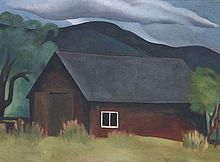
Owing to the legal delays caused by Stieglitz's first wife and her family, it would take six years before he obtained a divorce. O'Keeffe and Stieglitz were married on December 11, 1924.[7][46]For the rest of their lives together, their relationship was, "a collusion....a system of deals and trade-offs, tacitly agreed to and carried out, for the most part, without the exchange of a word. Preferring avoidance to confrontation on most issues, O'Keeffe was the principal agent of collusion in their union," according to biographerBenita Eisler.[106]They lived primarily in New York City, but spent their summers at his father's family estate, Oaklawn, in Lake George in upstate New York.[46]
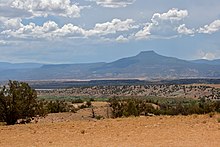
O'Keeffe and Stieglitz had an open relationship, which could be painful for O'Keeffe when Stieglitz had affairs with women.[109][c]In 1928, Stieglitz began a long-term affair withDorothy Norman,who was also married, and O'Keeffe lost a project to create amuralforRadio City Music Hall.She was hospitalized fordepression.[38]At the suggestion ofMaria ChabotandMabel Dodge Luhan,O'Keeffe began to spend the summers painting in New Mexico in 1929.[46]She traveled by train with her friend the painter Rebecca Strand,Paul Strand's wife, to Taos, where they lived with theirpatronwho provided them withstudios.[57]In 1933, O'Keeffe was hospitalized for two months after suffering anervous breakdown,largely due to Stieglitz's affair with Dorothy Norman.[111]She did not paint again until January 1934.[62]
O'Keeffe continued to visit New Mexico, without her husband, and created a new body of works based upon the desert.[112][d]O'Keeffe broke free of "strict gender roles" and adopted "gender neutral" clothing,[118]as did other professional women in Santa Fe and Taos who experienced "psychological space and sexual freedom" there.[114][109][116][119][e]
Shortly after O'Keeffe arrived for the summer in New Mexico in 1946, Stieglitz suffered acerebral thrombosis(stroke). She immediately flew to New York to be with him. He died on July 13, 1946. She buried his ashes at Lake George.[123]She spent the next three years mostly in New York settling his estate.[38]
She had a close relationship with Beck Strand. They enjoyed spending time together, traveling,[124]and living with "glee".[125]Strand said that she was most herself when with O'Keeffe. InFoursome—a book about O'Keeffe, Stieglitz, and Beck and Paul Strand—Carolyn Burkeargues against the notion that the women were sexually or romantically involved, finding such a reading of their correspondence incongruous with their "passionate ties to their husbands" and "strong heterosexual attractions".[124]
Frida Kahlomet O'Keeffe in December 1931 in New York City at the opening ofDiego Rivera's solo exhibition at the MOMA, after which a friendship developed.[126][f]They remained friends, staying in touch when O'Keeffe recuperated from a nervous breakdown in a hospital and then in Bermuda.[126][127]Both women visited each other's homes on a couple of occasions in the 1950s.[126]
Among guests to visit her at the ranch over the years wereCharles and Anne Lindbergh,singer-songwriterJoni Mitchell,poetAllen Ginsberg,and photographerAnsel Adams.[128]She traveled and camped at "Black Place" often with her friend, Maria Chabot, and later withEliot Porter.[62][76]
Legacy[edit]
Marquette Middle School inMadison, Wisconsinwas renamed as Georgia O'Keeffe Middle School.[129]
In 2020, Tymberwood Academy (in Gravesend, Kent, England), pupils chose new class names. One of the winning names for a Year 3 class was Georgia O'Keeffe.[130]
Georgia O'Keeffe Museum[edit]

O'Keeffe was a legend beginning in the 1920s, known as much for her independent spirit and female role model as for her dramatic and innovative works of art.[89]Nancy and Jules Heller said, "The most remarkable thing about O'Keeffe was the audacity and uniqueness of her early work." At that time, even in Europe, there were few artists exploring abstraction. Even though her works may show elements of different modernist movements, such as Surrealism and Precisionism, her work is uniquely her own style.[131]
A substantial part of her estate's assets were transferred to the Georgia O'Keeffe Foundation, a nonprofit. The Georgia O'Keeffe Museum opened in Santa Fe in 1997.[89]The assets included a large body of her work, photographs, archival materials, and her Abiquiú house, library, and property. TheGeorgia O'Keeffe Home and Studioin Abiquiú was designated aNational Historic Landmarkin 1998, and is now owned by the Georgia O'Keeffe Museum.[73]A fossilized species ofarchosaurwas namedEffigia okeeffeae( "O'Keeffe's Ghost" ) in January 2006, "in honor of Georgia O'Keeffe for her numerous paintings of the badlands at Ghost Ranch and her interest in theCoelophysisQuarry when it was discovered ".[132]In November 2016, the Georgia O'Keeffe Museum recognized the importance of her time in Charlottesville by dedicating an exhibition, using watercolors that she had created over three summers. It was entitled,O'Keeffe at the University of Virginia, 1912–1914.[29]
Popular culture[edit]
In 1991,PBSaired theAmerican PlayhouseproductionA Marriage: Georgia O'Keeffe and Alfred Stieglitz,starringJane Alexanderas O'Keeffe andChristopher Plummeras Alfred Stieglitz.[133]In 1996, theU.S. Postal Serviceissued a 32-cent stamp honoring O'Keeffe.[134]In 2013, on the 100th anniversary of theArmory Show,the USPS issued a stamp featuring O'Keeffe'sBlack Mesa Landscape, New Mexico/Out Back of Marie's II, 1930as part of their Modern Art in America series.[135]Lifetime Televisionproduceda biopic of Georgia O'KeeffestarringJoan Allenas O'Keeffe,Jeremy Ironsas Alfred Stieglitz,Henry SimmonsasJean Toomer,Ed Begley Jr.as Stieglitz's brother Lee, andTyne Dalyas Mabel Dodge Luhan. It premiered on September 19, 2009.[136][137]
On November 20, 2014, O'Keeffe'sJimson Weed/White Flower No 1(1932) sold for $44,405,000 in 2014 at auction toWalmartheiressAlice Walton,more than three times the previous world auction record for any female artist.[138][139]
Women's suffrage and feminism[edit]
InEqual Under the Sky: Georgia O'Keeffe and Twentieth Century Feminism,Linda M. Grasso documents O'Keeffe's life-long involvement in feminism and women's issues. O'Keeffe came of age as a woman and an artist in the 1910s, at the height of thewomen's suffrage movementand the intense artistic ferment ofmodernism.Grasso notes that "Modernists championed rupture, innovation, and daring in art forms, styles, and perspectives," and that O'Keeffe "first created herself as an artist when feminism and modernism were interlinked".[140]As early as 1915, O'Keeffe was reading books and articles on women's suffrage and cultural politics with enthusiasm, such asFloyd Dell'sWomen as World Builders: Studies in Modern Feminism.[141]There was much talk in this era about the "New Woman,"liberated from Victorian strictures and mores and pursuing her own life and education and self-expression freely. O'Keeffe was in active dialogue with her suffragist friend Anita Pollitzer, with whom she exchanged letters on the subject. Pollitzer, in fact, was the first person to introduce Alfred Stieglitz to O'Keeffe's art work.[142]She was also readingCharlotte Perkins GilmanandOlive Schreiner,among others, alongside the radical magazineThe Masses,and lecturing on modernist dancerIsadora Duncan.In a debate withMichael Goldin 1930, O'Keeffe said she was "interested in the oppression of women of all classes".[143]Gross writes: "She sustained an affiliation with the National Woman's Party and made public statements about gender discrimination and women's rights in interviews, speeches, letters, and articles into the 1970s."[144]
She received unprecedented acceptance as a woman artist from the fine art world due to her powerful graphic images and within a decade of moving to New York City, she was the highest-paid American woman artist.[145]She was known for a distinctive style in all aspects of her life.[146]
Mary Beth Edelson'sSome Living American Women Artists / Last Supper(1972) appropriatedLeonardo da Vinci'sThe Last Supper,with the heads of notable women artists collaged over the heads of Christ and his apostles.John the Apostle's head was replaced withNancy Graves,and Christ's with Georgia O'Keeffe. This image, addressing the role of religious and art historical iconography in the subordination of women, became "one of the most iconic images of thefeminist art movement."[147][148]Judy Chicagogave O'Keeffe a prominent place in herThe Dinner Party(1979) in recognition of what many prominent feminist artists considered groundbreaking introduction of sensual and feminist imagery in her works of art.[149]Although feminists celebrated O'Keeffe as the originator of "female iconography",[150]she did not consider herself a feminist.[151]She disliked being called a "woman artist" and wanted to be considered an "artist."[152]
Publications[edit]
- O'Keeffe, Georgia (1976).Georgia O'Keeffe.New York: Viking Press.ISBN978-0-670-33710-1.
- O'Keeffe, Georgia (1988).Some Memories of Drawings.Albuquerque, NM: University of New Mexico Press.ISBN978-0-8263-1113-9.
- O'Keeffe, Georgia (1993).Georgia O'Keeffe: American and Modern.New Haven: Yale University.ISBN978-0-300-05581-8.
- From her correspondence
- Giboire, Clive, ed. (1990).Lovingly, Georgia: The Complete Correspondence of Georgia O'Keeffe & Anita Pollitzer.New York: Simon & Schuster.ISBN978-0-671-69236-0.
- Greenough, Sarah, ed. (2011).My Faraway One: Selected Letters of Georgia O'Keeffe and Alfred Stieglitz.Vol. One, 1915–1933 (Annotated ed.). New Haven, CT: Yale University Press.ISBN978-0-300-16630-9.
Notes[edit]
- ^Vassar Collegeand theSmithsonian Institutionstate that the sitter is identified as O'Keeffe.[11]The bookA Woman on Paper: Georgia O'KeeffebyAnita Pollitzerstates that the painting is a portrait of O'Keeffe.[12][13]TheGeorgia O'Keeffe Museumdoes not say the painting is of O'Keeffe, but the record of the painting is filed in a category for Georgia O'Keeffe photographs and clippings.[14]
- ^abThe works are generally stated asSky Above Cloudsin books[81]and at the SIRUS system at the Smithsonian Institution,[82]but the work at The Art Institute of Chicago is "Sky above Clouds".[83]
- ^She also said that she was happy being "me" rather than worrying about affairs that Stieglitz might be having.[110]
- ^In the 1920s and 1930s, Santa Fe and Taos were havens for men and women who wanted to live unburdened by societal norms about sexuality.[113][114]During that time, "artists flocked to New Mexico inspired by its vast natural beauty and the indigenous cultures that were so different from their own."[115]Lesbian women in the fields of photography, archaeology, and anthropology were drawn to the area professionally and personally.[114]O'Keeffe knew lesbian and bisexual women[116]According toEl Palacio,she tended to avoid Santa Fe's lesbian women.[117]She was friends with bisexual and gay men, likeCady Wells,who was a lifelong friend.[117]
- ^O'Keeffe preferred to focus on her artistic skills than her sexual orientation.[113][120]She did not claim to be bisexual, and there are differing opinions about her sexuality.[118]Benita Eisler,author ofO'Keeffe & Stieglitz: An American Romance,was the first biographer to state that O'Keeffe was a bisexual. She came to that conclusion from reading letters between Beck and Paul Strand.[121]Colin B. Bailey, Director of Museums, Fine Arts Museums of San Francisco stated that people who wrote that O'Keeffe was bisexual brought the topic into "murky historical waters".[122]
- ^In 1932,Frida Kahloand her husband moved from NYC to Detroit. Here, Kahlo painted the famous Self Portrait on the Borderline Between Mexico and the United States. Many historians have noted the jack-in-the-pulpit flowers which lie on the Mexico side of the painting. These flowers, which are not native to Mexico, were the feature of a series of paintings by O'Keeffe just two years prior in which she painted the flowers at different periods of growth: one fully closed, one open, etc. This same series of growth is featured in Kahlo's painting.[126]
Citations[edit]
- ^ab"Life and Artwork of Georgia O'Keeffe".C-SPAN.January 9, 2013.Archivedfrom the original on June 6, 2014.RetrievedMarch 14,2013.
- ^Messinger, Lisa (October 2004)."Georgia O'Keeffe (1887–1986)".Heilbrunn Timeline of Art History.New York: The Metropolitan Museum of Art.Archivedfrom the original on July 12, 2023.RetrievedMay 29,2023.
- ^"Georgia O'Keeffe | American painter".Encyclopedia Britannica.Archivedfrom the original on September 29, 2019.RetrievedOctober 11,2019.
- ^"Georgia O'Keeffe".The North Carolina Museum of Art.Archivedfrom the original on June 26, 2023.RetrievedJune 26,2023.
- ^Christiane, Weidemann (2008).50 women artists you should know.Larass, Petra., Klier, Melanie. Munich: Prestel.ISBN978-3-7913-3956-6.OCLC195744889.Archivedfrom the original on April 4, 2020.RetrievedMarch 4,2020.
- ^"Georgia O'Keeffe".MacDowell.Archivedfrom the original on June 26, 2023.RetrievedJune 26,2023.
- ^ab"Texas State Historical Association (TSHA) - TSHA Gala featuring Clay Walker".tsha.wildapricot.org.RetrievedFebruary 28,2024.
- ^"An unabashedly sensual approach to a genteel genre".Newsweek.110:74–75. November 9, 1987 – via Readers' Guide Abstracts.
- ^Avishai, Tamar."Episode 45: Georgia O'Keeffe's Deer's Skull With Pedernal (1936)".The Lonely Palette(Podcast).RetrievedDecember 25,2020.
- ^Rile, Karen (December 1, 2014)."Georgia O'Keeffe and the $44 Million Jimson Weed".JSTOR Daily.Archivedfrom the original on December 4, 2021.RetrievedMarch 31,2022.
- ^"The Checkered Dress".National Portrait Gallery, Smithsonian Institution.Archivedfrom the original on July 1, 2023.RetrievedJuly 4,2023.
- ^"The Checkered Dress".emuseum, Vassar.Archivedfrom the original on July 1, 2023.RetrievedJuly 4,2023.
- ^A woman on paper: Georgia O'Keeffe.1988. p. 94.
- ^"The Checkered Dress by Hilda Belcher, clipping, undated".Georgia O'Keeffe Museum.Archivedfrom the original on July 1, 2023.RetrievedJuly 4,2023.
- ^abcdefghijklmnopqrs"Georgia O'Keeffe".Biography Channel.A&E Television Networks. August 26, 2016.Archivedfrom the original on January 16, 2017.RetrievedJanuary 14,2017.
- ^"Birth Record Details".Wisconsin Historical Society. Archived fromthe originalon November 7, 2012.RetrievedJuly 23,2009.
- ^"Birthplace of Georgia O'Keeffe".Sun Prairie, WI.Archived fromthe originalon July 29, 2016.
- ^Wisconsin Legislature.2013–14 Wisconsin Statutes 2013–14 S.84.1021 Georgia O'Keeffe Memorial Highway.ArchivedSeptember 28, 2015, at theWayback Machine
- ^abcRobinson, Roxana (1989).Georgia O'Keeffe: A Life.Hanover: University Press of New England. pp. 191–193.ISBN0-87451-906-3.
- ^abNancy Hopkins Reily (2007).Georgia O'keeffe, a Private Friendship: Walking the Sun Prairie Land.Sunstone Press. p. 54.ISBN978-0-86534-451-8.
- ^abcdefgRoberts, Norma J., ed. (1988),The American Collections,Columbus Museum of Art,p.76,ISBN0-8109-1811-0
- ^Canterbury, Sue (2018).Ida O'Keeffe: Escaping Georgia's Shadow.Dallas, Texas: Dallas Museum of Art. p. 15.ISBN978-0-300-21456-7.
- ^"Colonial Williamsburg Research & Education".colonialwilliamsburg.org.Archivedfrom the original on April 9, 2020.RetrievedApril 9,2020.
- ^Rath, Sara; Smith, Rick (1977).Madison and Dane County.Tamarack Press. p. 91.ISBN978-0-915024-13-1.Archivedfrom the original on July 25, 2023.RetrievedJuly 25,2023.
- ^Gerry Souter (2017).Georgia O'Keeffe.Parkstone International. pp. 34–35.ISBN978-5-457-46766-8.
- ^Holland Cotter (January 5, 2017)."World War I: The Quick. The Dead. The Artists".The New York Times.Archivedfrom the original on January 11, 2017.RetrievedJanuary 16,2017.
- ^Kathaleen Roberts (November 20, 2016)."Never-before-exhibited O'Keeffe paintings show shift to abstraction".Albuquerque Journal.Archivedfrom the original on January 16, 2017.RetrievedJanuary 14,2017.
- ^abcdeAmon Carter Museum of Western Art; Patricia A. Junker; Will Gillham (2001).An American Collection: Works from the Amon Carter Museum.Hudson Hills. p. 184.ISBN978-1-55595-198-6.
- ^ab"How UVA shaped Georgia O'Keeffe".University of Virginia.November 10, 2016.Archivedfrom the original on January 16, 2017.RetrievedJanuary 14,2017.
- ^Zilczer, Judith (1999). "'Light Coming on the Plains': Georgia O'Keeffe's Sunrise Series ".Artibus et Historiae.20(40): 193–194.doi:10.2307/1483675.JSTOR1483675.
- ^abcdeEleanor Tufts; National Museum of Women in the Arts; International Exhibitions Foundation (1987).American women artists, 1830–1930.International Exhibitions Foundation for the National Museum of Women in the Arts. p. 81.ISBN978-0-940979-01-7.Archivedfrom the original on April 27, 2017.RetrievedJanuary 20,2017.
- ^Zilczer, Judith (1999). "'Light Coming on the Plains': Georgia O'Keeffe's Sunrise Series ".Artibus et Historiae.20(40): 191–208.doi:10.2307/1483675.JSTOR1483675.
- ^abSharyn Rohlfsen Udall (2000).Carr, O'Keeffe, Kahlo: Places of Their Own.Yale University Press. p.114.ISBN978-0-300-09186-1.
- ^Michael Abatemarco (April 29, 2016)."Birth of the abstract: Georgia O'Keeffe in Amarillo".Santa Fe New Mexican.Archivedfrom the original on February 23, 2018.RetrievedJanuary 18,2017.
- ^abcRathbone, Belinda; Shattuck, Roger; Turner, Elizabeth Hutton; Arrowsmith, Alexandra; West, Thomas (1992).Two Lives, Georgia O'Keeffe & Alfred Stieglitz: A Conversation in Paintings and Photographs.HarperCollins.ISBN0-06-016895-1.OCLC974243303.
- ^abEldredge, Charles C. (1991). "Life and Legend".Georgia O'Keeffe.The library of American art. New York: Harry N. Abrams. pp. 11–19.ISBN978-0-8109-3657-7.
- ^Eldredge, Charles C.; Schimmel, Julie; Truettner, William H., eds. (1986).Art in New Mexico, 1900–1945: Paths to Taos and Santa Fe.Washington, D.C: National Museum of American Art, Smithsonian Institution. p. 205.ISBN978-0-89659-599-6.
- ^abcdefghijCarol Kort; Liz Sonneborn (2002).A to Z of American Women in the Visual Arts.New York: Facts on File. p. 170.ISBN0-8160-4397-3.
- ^abBirmingham Museum of Art(2010).Birmingham Museum of Art: guide to the collection.Alabama: Birmingham Museum of Art. p. 144.ISBN978-1-904832-77-5.Archivedfrom the original on December 18, 2015.RetrievedJanuary 15,2016.
- ^"Blue and Green Music".Art Institute of Chicago.Archivedfrom the original on January 12, 2017.RetrievedJanuary 18,2017.
- ^abRosenfeld, Paul (October 1922). "The Paintings of Georgia O'Keeffe".Vanity Fair.pp. 56, 112, 114.
- ^abKristy Puchko (April 21, 2015)."15 Things You Should Know About Georgia O'Keeffe".Mental Floss.Archivedfrom the original on January 31, 2017.RetrievedJanuary 14,2017.
- ^Liese Spencer (December 31, 2015)."From Georgia O'Keeffe to War and Peace: Unmissable Arts Events in 2016".The Guardian.Archivedfrom the original on January 18, 2017.RetrievedJanuary 13,2017.
- ^Laura Cumming (April 7, 2012)."The 10 best flower paintings in pictures".The Guardian.Archivedfrom the original on January 18, 2017.RetrievedJanuary 13,2017.
- ^Barbara Buhler Lynes; Jonathan Weinberg; Georgia O'Keeffe Museum (2011).Shared Intelligence: American Painting and the Photograph.Univ of California Press. p. 92.ISBN978-0-520-26906-4.
- ^abcdefghRobert Torchia (September 29, 2016)."O'Keeffe, Georgia: Biography".National Gallery of Art.Archivedfrom the original on January 18, 2017.RetrievedJanuary 14,2017.
- ^"Manhattan Residences of Georgia O'Keeffe and Patricia Highsmith Published".NYC LGBT Historic Sites Project.Archivedfrom the original on December 18, 2019.RetrievedDecember 18,2019.
- ^ab"Georgia O'Keeffe (1887–1986): East River from the Thirtieth Story of the Shelton Hotel, 1928".New Britain Museum of American Art.Archived fromthe originalon June 24, 2016.RetrievedJanuary 17,2017.
- ^ab"Important Art by Georgia O'Keeffe: Radiator Building – Night, New York".The Art Story.Archivedfrom the original on January 18, 2017.RetrievedJanuary 17,2017.
- ^"Radiator Building – Night, New York".Crystal Bridges Museum of American Art.Archivedfrom the original on October 18, 2016.RetrievedJanuary 17,2017.
- ^"Georgia O'Keeffe: New York Street with Moon, 1925".Museo Thyssen-Bornemisz.Archivedfrom the original on December 19, 2016.RetrievedJanuary 17,2017.
- ^"The Shelton with Sunspots, N.Y., 1926".Art Institute of Chicago.Archivedfrom the original on January 18, 2017.RetrievedJanuary 17,2017.
- ^Hunter Drohojowska-Philp (November 17, 2005).Full Bloom: The Art and Life of Georgia O'Keeffe.W. W. Norton. p. 282.ISBN978-0-393-32741-0.
- ^abVivien Green Fryd (2003).Art and the Crisis of Marriage: Edward Hopper and Georgia O'Keeffe.University of Chicago Press. p. 164.ISBN978-0-226-26654-1.
- ^Hunter Drohojowska-Philp (2005).Full Bloom: The Art and Life of Georgia O'Keeffe.W. W. Norton. p. 282.ISBN978-0-393-32741-0.
- ^Drohojowska-Philp, Hunter (2004).Full Bloom: The Art and Life of Georgia O'Keeffe.New York, NY: W. W. Norton. pp. 294–296.ISBN978-0-393-32741-0.
- ^abcMaurer, Rachel."The D. H. Lawrence Ranch".University of New Mexico.Archived fromthe originalon June 25, 2009.RetrievedSeptember 15,2009.
- ^Richmond-Moll, Jeffrey."Georgia O'Keeffe, Black Cross with Stars and Blue"(PDF).Archived(PDF)from the original on August 12, 2019.
- ^Messinger, Lisa (October 2004)."Georgia O'Keeffe (1887–1986)".Heilbrunn Timeline of Art History.New York: The Metropolitan Museum of Art.Archivedfrom the original on July 12, 2023.RetrievedMay 29,2023.
- ^"The Lawrence Tree".Wadsworth Athenaeum.Hartford, Connecticut. Archived fromthe originalon February 18, 2017.RetrievedJanuary 18,2017.
- ^Eleanor Tufts; National Museum of Women in the Arts; International Exhibitions Foundation (1987).American women artists, 1830–1930.International Exhibitions Foundation for the National Museum of Women in the Arts. p. 83.ISBN978-0-940979-01-7.Archivedfrom the original on February 14, 2017.RetrievedJanuary 20,2017.
- ^abcdefgh"Rotating O'Keeffe exhibit".Fort Worth, Texas: National Cowgirl Museum and Hall of Fame. 2010. Archived fromthe originalon October 14, 2012.
- ^abc"Summer Days".Georgia O'Keeffe Museum.Archivedfrom the original on February 8, 2017.RetrievedJanuary 18,2017.
- ^Norris, Kathleen, Wagner M., Anne, Peters, Sarah Whitaker (1999). "Georgia O'Keeffe. Summer Days. 1936". In Venn, Beth (ed.).Frames of Reference: Looking at American art, 1900-1950. Works from the Whitney Museum of American Art.Berkeley, California: University of California Press. pp. 203–211.ISBN978-0-520-21888-8.
{{cite book}}:CS1 maint: multiple names: authors list (link) - ^"Summer Days".Whitney Museum of American Art.Archivedfrom the original on February 2, 2017.RetrievedJanuary 18,2017.
- ^Saville, Jennifer (1990),Georgia O'Keeffe: Paintings of Hawai'i,Honolulu: Honolulu Academy of Arts, p. 13
- ^Jennings, Patricia & Maria Ausherman,Georgia O'Keeffe's Hawai'i,Koa Books,Kihei, Hawaii,2011, p. 3
- ^Papanikolas, Theresa,Georgia O'Keeffe and Ansel Adams, The Hawai'I Pictures,Honolulu Museum of Art, 2013
- ^Severson, Don R. (2002),Finding Paradise: Island Art in Private Collections,University of Hawaii Press, p. 119
- ^abTony Perrottet (November 30, 2012),O'Keeffe's HawaiiArchivedDecember 2, 2012, at theWayback MachineNew York Times.
- ^"Georgia O'Keeffe Paints Hawaii".National Endowment for the Humanities (NEH).Archivedfrom the original on February 5, 2020.RetrievedApril 9,2020.
- ^Severson, Don R. (2002),Finding Paradise: Island Art in Private Collections,University of Hawaii Press, p. 128
- ^abVictor J. Danilov (2013).Famous Americans: A Directory of Museums, Historic Sites, and Memorials.Scarecrow Press. p. 17.ISBN978-0-8108-9186-9.Archivedfrom the original on February 14, 2017.RetrievedJanuary 20,2017.
- ^Kilian, Michael (August 1, 2002)."Santa Fe exhibit paints a different picture of O'Keeffe".Chicago Tribune.Archivedfrom the original on December 4, 2010.RetrievedOctober 10,2010.
... her place, through the eyes and lens of her close and longtime friend, photographer Todd Webb (1905–2000), who produced a glorious collection of photos of her and her surroundings at her Ghost Ranch and Abiquiú houses between 1955 and 1981.
- ^Zimmer, William (December 31, 2000)."Art; Exploring the Affinities Among Painting, Music and Dance".The New York Times.Archivedfrom the original on June 21, 2018.RetrievedOctober 10,2010.
O'Keeffe's prickly personality is legendary, but with Webb she displays the kind of quietness and calm she wanted to embody.
- ^abPorter's photograph,Eroded Clay and Rock Flakes, Black Place, New Mexico, July 20, 1953,on cartermuseum.org, in theAmon Carter MuseumEliot Porter CollectionArchivedAugust 19, 2016, at theWayback MachineRetrieved June 16, 2010
- ^"The White Place in Sun, 1943".Art Institute of Chicago.Archivedfrom the original on February 1, 2017.RetrievedJanuary 18,2017.
- ^Nancy Hopkins Reily (2009).Georgia O'Keeffe, a Private Friendship: Walking the Abiquiu and Ghost Ranch land.Sunstone Press. pp. 152–153.ISBN978-0-86534-452-5.Archivedfrom the original on February 14, 2017.RetrievedJanuary 20,2017.
- ^Volpe, Lisa; Plotek, Ariel (2021).Georgia O'Keefe, Photographer.New Haven, CT: Yale University Press.ISBN9780300257809.
- ^Nancy Hopkins Reily (2009).Georgia O'Keeffe, a Private Friendship: Walking the Abiquiu and Ghost Ranch land.Sunstone Press. p. 325.ISBN978-0-86534-452-5.Archivedfrom the original on February 14, 2017.RetrievedJanuary 20,2017.
- ^""Sky above clouds" O'Keeffe - Google Search ".google.RetrievedSeptember 1,2023.
- ^"Search results for:" Sky above Clouds "".Collections Search Center, Smithsonian Institution.RetrievedSeptember 1,2023.
- ^"Sky above Clouds IV".1965.RetrievedSeptember 1,2023.
- ^abLynes, Barbara Buhler (Fall 2006)."Visiting Georgia O'Keeffe".American Art.20(3): 2–7.doi:10.1086/511089.JSTOR511089.S2CID191326344.RetrievedNovember 22,2023.
From 1972 to 1976–77, O'Keeffe continued to work in oil, pastel, and watercolor, but only with assistance. She could work unassisted in charcoal and pencil, however, and did so until 1984.
- ^"Biography".The Georgia O'Keeffe Museum.Archivedfrom the original on November 15, 2023.RetrievedNovember 22,2023.
O'Keeffe painted her last unassisted oil painting in 1972
- ^"Who Was Georgia O'Keeffe's Younger Man, Juan Hamilton?".Artdex.January 26, 2021.Archivedfrom the original on September 19, 2021.RetrievedSeptember 16,2021.
- ^Jack Salzman (1990).American Studies: An Annotated Bibliography 1984–1988.Cambridge University Press. p. 112.ISBN978-0-521-36559-8.Archivedfrom the original on February 14, 2017.RetrievedJanuary 20,2017.
- ^Asbury, Edith Evans (March 7, 1986)."Obituary: Georgia O' Keeffe Dead at 98; Shaper of Modern Art in U.S."The New York Times.Archivedfrom the original on September 29, 2009.RetrievedJune 13,2010.
- ^abcdCarol Kort; Liz Sonneborn (2002).A to Z of American Women in the Visual Arts.New York: Facts on File. p. 171.ISBN0-8160-4397-3.
- ^"Settlement Is Granted Over O'Keeffe Estate".The New York Times.Associated Press. July 26, 1987.Archivedfrom the original on February 15, 2009.RetrievedNovember 17,2022.
- ^Dingus, Anne (July 1, 1997)."Georgia O'Keeffe".Texas Monthly.Archivedfrom the original on November 17, 2022.RetrievedNovember 17,2022.
- ^Vaughn W. Henry (May 10, 2004)."Establishing a Value is Important!".Planned Giving Design Center, LLC. Archived fromthe originalon February 13, 2007.RetrievedJanuary 3,2007.
- ^"Special Collections Research Center Knowledgebase".Archivedfrom the original on August 14, 2021.RetrievedOctober 29,2020.
- ^"Book of Members, 1780–2010: Chapter O"(PDF).American Academy of Arts and Sciences.Archived(PDF)from the original on June 13, 2011.RetrievedApril 14,2011.
- ^The National First Ladies Library (2010).Heroes of the Presidential Medal of Freedom(PDF).Canton Ohio. p. 3.Archived(PDF)from the original on February 14, 2011.RetrievedFebruary 11,2011.
Georgia O'Keeffe (1887–1986)...Presidential Medal of Freedom received January 10, 1977
{{cite book}}:CS1 maint: location missing publisher (link) - ^John F. Matthews (June 15, 2010)."O'Keeffe, Georgia Otto".Handbook of Texas Online.Archivedfrom the original on December 31, 2015.RetrievedJanuary 17,2016.
- ^Kessler, Renata Renee (2021).The Flowers and Bones of Georgia O'Keeffe: A Research-Based Dissertation Culminating in a Full-Length Play: Days with Juan(Thesis).ProQuest2516220633.
- ^Nochlin, Linda; Reilly, Maura (2015). "Some Women Realists: Part 1".Women artists: the Linda Nochlin reader.National Geographic Books. pp. 76–85.ISBN978-0-500-23929-2.
- ^Tessler, Nira (2015).Flowers and Towers: Politics of Identity in the Art of the American 'New Woman'.Cambridge Scholars Publishing.ISBN978-1-4438-8623-9.
- ^abcMitchell, Marilyn Hall (1978). "Sexist Art Criticism: Georgia O'Keeffe: A Case Study".Signs.3(3): 681–687.doi:10.1086/493510.JSTOR3173179.S2CID144414057.
- ^"Sex, Stieglitz and Georgia O'Keeffe | art | Agenda | Phaidon".phaidon.Archivedfrom the original on March 15, 2022.RetrievedMarch 31,2022.
- ^Gates, Alison A. (2021). "Georgia O'Keeffe: Inevitable Icon".Feminist Collections.42(1/2): 12–13.ProQuest2565692463.
- ^Whelan, Richard (1995).Alfred Stieglitz: a biography(1st ed.). Boston: Little, Brown.ISBN0-316-93404-6.OCLC31516122.
- ^Brennan, Marcia (2002).Painting Gender, Constructing Theory: The Alfred Stieglitz Circle and American Formalist Aesthetics.MIT Press.ISBN0-262-52336-1.
- ^Lynes, Barbara (1989).O'Keeffe, Stieglitz and the Critics, 1916–1929.Ann Arbor, Michigan: UMI Research Press. pp.55–56.ISBN0-8357-1930-8.
- ^McKenna, Kristine (June 2, 1991)."The Young and the Restless: O'Keeffe & Stieglitz: An American Romance, By Benita Eisler (Doubleday: 560 pp.)".Los Angeles Times.Archivedfrom the original on April 16, 2017.RetrievedApril 15,2017.
- ^Abrams, Dennis. O'Keeffe, Georgia. 2009.Georgia O'Keeffe.Infobase Publishing, p. 97
- ^A similar remark is registered in"Her Story and Her Work"ArchivedOctober 29, 2011, at theWayback Machineby Bill Long, 6/29/07.: "I painted it often enough thinking that, if I did so, God would give it to me."
- ^abPalmer, Natalee G."From Feminists to Public Figures: Frida Kahlo, Georgia O'Keeffe, and Suzanne Lacy".Natalee Palmer's Spanish 07 Portfolio.Archivedfrom the original on July 3, 2023.RetrievedJuly 3,2023.
- ^Burke 2020,p. 200.
- ^Hunter Drohojowska-Philp (2005).Full Bloom: The Art and Life of Georgia O'Keeffe.W. W. Norton. pp. 5–6.ISBN978-0-393-32741-0.Archivedfrom the original on February 14, 2017.RetrievedJanuary 20,2017.
- ^100 Most Important Women of the 20th century.Ladies' Home Journal Books. 1998. p. 140.ISBN9780696208232.
- ^ab"Subtexts: Georgia O'Keeffe".The Santa Fe New Mexican.March 11, 2016. p. Z016.Archivedfrom the original on July 3, 2023.RetrievedJuly 3,2023.
- ^abcEisler 1992,p. 458.
- ^"New Mexico Art Tells New Mexico History".New Mexico Museum of Art.Archivedfrom the original on June 5, 2023.RetrievedJuly 4,2023.
- ^abGarber, Marjorie (May 13, 2013).Bisexuality and the Eroticism of Everyday Life.Taylor & Francis. pp. 113–115, 288.ISBN9781136612831.Archivedfrom the original on August 31, 2023.RetrievedJuly 9,2023.
- ^ab"The View from Out There Cady Wells: Ruminations at the New Mexico Museum of Art".El Palacio.June 2017.RetrievedJuly 3,2023.
- ^abEllison, Rachel (June 18, 2019)."Pride: LGBTQ+ Artists and CAM".Cincinnati Art Museum.Archivedfrom the original on July 3, 2023.RetrievedJuly 3,2023.
- ^Eisler 1992,pp. 398, 505.
- ^Burke 2020,p. 320.
- ^Foerstner, Abigail (July 28, 1991)."O'Keeffe was no saint, tell-all book reveals".Archivedfrom the original on July 2, 2023.RetrievedJuly 3,2023.
- ^"Modern Nature: Georgia O'Keeffe and Lake George".San Francisco Bay Times.Archivedfrom the original on July 3, 2023.RetrievedJuly 3,2023.
- ^Dennis Abrams; Georgia O'Keeffe (2009).Georgia O'Keeffe.Infobase Publishing. p. 100.ISBN978-1-4381-2827-6.Archivedfrom the original on February 14, 2017.RetrievedJanuary 20,2017.
- ^abBurke 2020,p. 202.
- ^Burke 2020,pp. 202, 206.
- ^abcdChernick, Karen (April 7, 2020)."Kahlo and O'Keeffe: the formative friendship between two artistic giants".CNN.Archivedfrom the original on October 22, 2022.RetrievedOctober 22,2022.
- ^Kettler, Sara (July 14, 2020)."Behind Frida Kahlo's Real and Rumored Affairs With Men and Women".Biography.Archivedfrom the original on October 22, 2022.RetrievedOctober 22,2022.
- ^Jonathan Stewart (2014).Walking Away From The Land: Change At The Crest Of A Continent.Xlibris Corporation. p. 319.ISBN978-1-4931-8090-5.Archivedfrom the original on February 14, 2017.RetrievedJanuary 20,2017.[self-published source]
- ^"About us - Georgia O'Keeffe Middle School".okeeffe.madison.k12.wi.us.August 8, 2023.RetrievedFebruary 28,2024.
- ^"Reception (Lily Rice and Georgia O'Keeffe)".tymberwoodacademy.co.uk/.May 24, 2024.RetrievedMay 24,2024.
- ^Jules Heller; Nancy Heller (1995).North American Women Artists of the Twentieth Century: A Biographical Dictionary.Garland. p.416.ISBN978-0-8240-6049-7.Archivedfrom the original on December 16, 2019.RetrievedMarch 6,2020.
- ^Sterling J Nesbitt1, and Mark A Norell (May 7, 2006)."Extreme convergence in the body plans of an early suchian (Archosauria) and ornithomimid dinosaurs (Theropoda)".Proc Biol Sci.273(1590). The Royal Society: 1045–1048.doi:10.1098/rspb.2005.3426.PMC1560254.PMID16600879.
{{cite journal}}:CS1 maint: numeric names: authors list (link) - ^Susan King (July 14, 1991)."Focus: Georgia on Her Mind: Jane Alexander's Fascination With Artist O'Keeffe Leads to PBS' 'Playhouse'".Los Angeles Times.Archivedfrom the original on February 1, 2017.RetrievedJanuary 18,2017.
- ^"Stamp Series".United States Postal Service. Archived fromthe originalon August 10, 2013.RetrievedSeptember 2,2013.
- ^"Modern Art in America 1913–1931, Forever".USPS.Archivedfrom the original on March 16, 2015.RetrievedMarch 8,2015.
- ^"Georgia O'Keeffe".Lifetime Television's. Archived fromthe originalon August 30, 2009.
- ^Vincent Terrace (2010).The Year in Television, 2009: A Catalog of New and Continuing Series, Miniseries, Specials and TV Movies.McFarland. p. 59.ISBN978-0-7864-5644-4.Archivedfrom the original on February 14, 2017.RetrievedJanuary 20,2017.
- ^"Auction Results: American Art".Sotheby's.November 20, 2014.Archivedfrom the original on September 11, 2016.RetrievedJanuary 19,2017.
- ^"Jimson Weed/White Flower No. 1, 1932 by Georgia O'Keeffe".georgiaokeeffe.net.Archivedfrom the original on July 22, 2020.RetrievedJune 10,2020.
- ^Grasso 2017,p. 3.
- ^Grasso 2017,p. 23.
- ^Grasso 2017,p. 52.
- ^Grasso 2017,p. 4.
- ^Grasso 2017,p. 104.
- ^Hunter Drohojowska-Philp (2005).Full Bloom: The Art and Life of Georgia O'Keeffe.W.W. Norton. pp. 4–5.ISBN978-0-393-32741-0.Archivedfrom the original on February 14, 2017.RetrievedJanuary 20,2017.
- ^Alexandra Lange (June 23, 2017)."Jane Jacobs, Georgia O'Keeffe, and the Power of the Marimekko Dress".The New Yorker.Archivedfrom the original on June 29, 2018.RetrievedJuly 25,2018.
- ^"Mary Beth Edelson".The Frost Art Museum Drawing Project.Archivedfrom the original on January 11, 2014.RetrievedJanuary 11,2014.
- ^"Mary Beth Adelson".Database of Women Artists (Clara).Washington, D.C.: National Museum of Women in the Arts. Archived fromthe originalon January 10, 2014.RetrievedJanuary 10,2014.
- ^Georgia O'Keeffe Place Setting,Brooklyn Museum,archivedfrom the original on June 20, 2015,retrievedJune 5,2015.
- ^"Georgia O'Keeffe".Brooklyn Museum.Archivedfrom the original on January 21, 2017.RetrievedJanuary 18,2017.
- ^"Georgia O'Keeffe at Tate Modern Review".Design Curial.October 10, 2016.Archivedfrom the original on February 2, 2017.RetrievedJanuary 18,2017.
- ^"Georgia O'Keeffe".Education, Smithsonian American Art Museum.Archived fromthe originalon June 29, 2012.RetrievedJanuary 20,2017.
References[edit]
- Burke, Carolyn (2020).Foursome.Knopf Doubleday Publishing Group.ISBN978-1-9848-9970-5.
- Eisler, Benita (1992).O'Keeffe and Stieglitz: An American Romance(Paperback reprint ed.). New York: Penguin Books.ISBN0140170944.
- Grasso, Linda (2017).Equal under the Sky: Georgia O'Keeffe and Twentieth-Century Feminism.Albuquerque: University of New Mexico Press.ISBN978-0826358813.
Further reading[edit]
- Eldredge, Charles C.(1991).Georgia O'Keeffe.New York:Harry N. Abrams, Inc.ISBN978-0-8109-3657-7.
- Haskell, Barbara, ed. (2009).Georgia O'Keeffe: Abstraction.Whitney Museum of American Art.New Haven, CT: Yale University Press.ISBN978-0-300-14817-6.
- Hogrefe, Jeffrey (1994).O'Keeffe: The Life of an American Legend.New York: Bantam.ISBN978-0-553-56545-4.
- Lisle, Laurie (1986).Portrait of an Artist.New York: Washington Square Press.ISBN978-0-671-60040-2.
- Lynes, Barbara Buhler(1999).Georgia O'Keeffe: Catalogue Raisonné.Washington, D.C.: National Gallery of Art.ISBN978-0-300-08176-3.
- Lynes, Barbara Buhler; Poling-Kempes, Lesley;Turner, Frederick W.(2004).Georgia O'Keeffe and New Mexico: A Sense of Place(3rd ed.). Princeton, NJ: Princeton University Press.ISBN978-0-691-11659-4.
- Lynes, Barbara Buhler (2007).Georgia O'Keeffe Museum Collections.Harry N. Abrams.ISBN978-0-8109-0957-1.
- Lynes, Barbara Buhler; Phillips, Sandra S. (2008).Georgia O'Keeffe and Ansel Adams: Natural Affinities.Little, Brown and Company.ISBN978-0-316-11832-3.
- Lynes, Barbara Buhler; Weinberg, Jonathan, eds. (2011).Shared Intelligence: American Painting and The Photograph.University of California Press.ISBN978-0-520-26906-4.
- Lynes, Barbara Buhler (2012).Georgia O'Keeffe and Her Houses: Ghost Ranch and Abiquiu.Harry N. Abrams.ISBN978-1-4197-0394-2.
- Lynes, Barbara Buhler (2012).Georgia O'Keeffe: Life & Work.Skira.ISBN978-88-572-1232-6.
- Merrill, C. S. (2010).Weekends with O'Keeffe.Albuquerque, NM: University of New Mexico Press.ISBN978-0-8263-4928-6.
- Messinger, Lisa Mintz (2001).Georgia O'Keeffe.London: Thames & Hudson.ISBN0-500-20340-7.
- Montgomery, Elizabeth (1993).Georgia O'Keeffe.New York: Barnes & Noble.ISBN978-0-88029-951-0.
- Orford, Emily-Jane Hills (2008).The Creative Spirit: Stories of 20th Century Artists.Ottawa: Baico Publishing.ISBN978-1-897449-18-9.
- Patten, Christine Taylor; Cardona-Hine, Alvaro (1992).Miss O'Keeffe.Albuquerque, NM: University of New Mexico Press.ISBN978-0-8263-1322-5.
- Peters, Sarah W. (1991).Becoming O'Keeffe.New York: Abbeville Press.ISBN978-1-55859-362-6.
- Pyle, Kathleen (2007).Modernism and the Feminine Voice: O'Keeffe and the Women of the Stieglitz Circle.Berkeley: University of California Press.ISBN978-0-520-24189-3.
- Volpe, Lisa; Plotek, Ariel (2021).Georgia O'Keefe, Photographer.New Haven, CT: Yale University Press.ISBN9780300257809.
- Winter, Jeanette (1998).My Name Is Georgia: A Portrait.San Diego, New York, London: First Voyager Books.ISBN0-15-201649-X.
External links[edit]
This article'suse ofexternal linksmay not follow Wikipedia's policies or guidelines.(April 2024) |
- Georgia O'Keeffe Museum Collections Online
- Smithsonian InstitutionInformation System:paintings,still lifes,photographs,andsculpture.
- Georgia O'Keeffeat theMuseum of Modern Art
- MoMA 2023 installation:"Georgia O'Keeffe: To See Takes Time"
- Patricia Marroquin Norby and Samantha Friedman,curators, comment on Georgia O'Keeffe,Untitled (Patio Door),1946, Museum of Modern Art (MoMA)
- Patricia Marroquin Norby,Native American curator, comments on Georgia O'Keeffe,Eagle Claw and Bean Necklace, 1934, Museum of Modern Art (MoMA)
- Works by Georgia O'KeeffeatOpen Library
- Alfred Stieglitz/Georgia O'Keeffe Archiveat theBeinecke Rare Book and Manuscript LibraryatYale University
- O'Keeffe!,a solo actor play by Lucinda McDermott,Playscripts, Inc.
- Georgia O'Keeffe
- 1887 births
- 1986 deaths
- 20th-century American painters
- American abstract painters
- American people of Hungarian descent
- American people of Irish descent
- American watercolorists
- Art Students League of New York alumni
- Artists from Santa Fe, New Mexico
- Cowgirl Hall of Fame inductees
- Fellows of the American Academy of Arts and Sciences
- Flower artists
- Hawaii artists
- Painters from New York City
- Painters from Wisconsin
- People from Abiquiú, New Mexico
- People from Amarillo, Texas
- People from Sun Prairie, Wisconsin
- People with mood disorders
- Precisionism
- Presidential Medal of Freedom recipients
- School of the Art Institute of Chicago alumni
- Students of William Merritt Chase
- Teachers College, Columbia University alumni
- United States National Medal of Arts recipients
- University of Virginia alumni
- West Texas A&M University faculty
- American women watercolorists
- 20th-century American women painters


